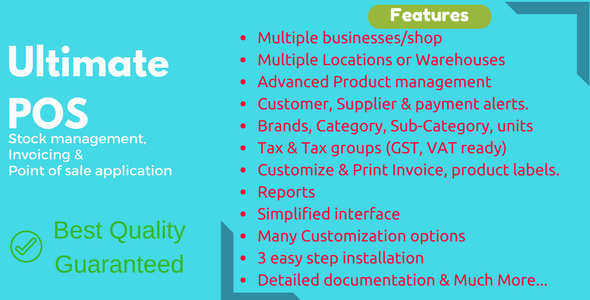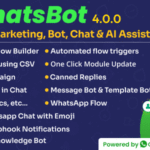- Ultimate POS v6.9 – Best ERP, Stock Management, Point of Sale & Invoicing application – Nulled
- Title: How “Ultimate POS” Simplifies Inventory, Invoicing & Sales for Growing Businesses
- What is Ultimate POS?
- Key Features & Highlights
- Use Cases & Who It’s Good For
- Strengths & Advantages
- Challenges & Considerations
- Best Practices for Implementation
- Sample Workflow: From Stock to Sale to Analysis
- How It Compares to Alternatives (SaaS, other ERPs)
- Conclusion
Ultimate POS v6.9 – Best ERP, Stock Management, Point of Sale & Invoicing application – Nulled
Title: How “Ultimate POS” Simplifies Inventory, Invoicing & Sales for Growing Businesses
In today’s fast-paced retail environment, small and medium businesses often struggle juggling inventory, sales, and finances across multiple channels. What if you could have a unified system that handles invoicing, stock control, point of sale (POS), and reporting — all under one roof?
That’s exactly what Ultimate POS – Stock Management & Point of Sale Application (on CodeCanyon) aims to deliver. Below, we explore its features, benefits, potential use cases, and things to watch out for.
What is Ultimate POS?
Ultimate POS is a software package (script) that you can purchase and deploy (self-host) — typically built in PHP (based on the listing category). It is marketed as a combined ERP, stock management, POS, and invoicing solution.
Key value proposition: instead of having separate systems for inventory, sales, billing, you get an integrated tool that allows you to:
-
Process sales via POS (in a retail environment)
-
Manage product stock / inventory
-
Generate invoices, receipts
-
Monitor business metrics, reports
The advantage is reducing data silos, avoiding manual transfers, and gaining real-time visibility.
Key Features & Highlights
Here are some of the standout features (as advertised) of Ultimate POS:
| Feature | What It Does | Why It Matters |
|---|---|---|
| POS (Point of Sale) Interface | Enables front-end sales operations (e.g. register, barcode scanning) | Speeds up checkout and reduces errors |
| Inventory / Stock Management | Tracks stock levels, adjustments, transfers, reorder points | Helps avoid stockouts or overstock |
| Invoicing & Billing | Generates invoices / receipts to customers | Professional billing, record keeping |
| Reporting & Analytics | Sales reports, profit reports, product performance | Helps you make data-driven decisions |
| Multi-user / Roles | Possibly supports different user roles (cashier, manager, admin) | Access control and accountability |
| Customization / Extensibility | Script files, ability to adapt to your business needs | You can tailor to your workflows |
Because it’s a code/script product (not a SaaS hosted product), you get more flexibility to host, modify, or integrate as needed — but also more responsibility (server, maintenance, backups, updates).
Use Cases & Who It’s Good For
Here are scenarios where Ultimate POS can be particularly useful:
-
Retail shops & boutiques: Managing day-to-day sales, stock, promotions, etc.
-
Small warehouses / wholesalers: Tracking stock flow and generating invoices to clients.
-
Multi-store operations (if supported): Synchronizing stock & sales across branches.
-
Businesses with on-site counters: e.g., pharmacies, small restaurants (if POS can adapt).
-
Entrepreneurs / developers: Those who want a base script they can customize instead of building from scratch.
For a small business in Kolkata or India, where local tax rules, GST, invoicing formats matter, this kind of tool can help reduce manual errors and streamline operations.
Strengths & Advantages
Here are a few advantages that make this kind of solution compelling:
-
Integration & Single Source of Truth
Instead of separate tools (Excel, billing software, stock app), everything lives in one system. -
Cost Efficiency
One-time purchase (plus hosting, maintenance) can be cheaper in the long run compared to recurring SaaS fees, especially for local business contexts. -
Control & Ownership
You host it yourself, so you control data, backups, security, and can customize features. -
Scalability / Customization
Open scripts allow adding features (custom reports, modules, interface tweaks) as your business grows. -
Better Visibility
Real-time stock tracking and sales analytics help you stay on top of performance and spot issues early.
Challenges & Considerations
However, there are also risks or limitations you should be aware of:
-
Technical Setup & Maintenance
Because it’s a self-hosted script, you’ll need a server (or web hosting), configuration, backups, security hardening, updates. -
Support & Updates
The quality of support (bug fixes, version upgrades) depends on the seller / item vendor. If updates slow or stop, your system may lag behind industry or security standards. -
Customization Complexity
For non-technical users, making deep customizations (say integrating with a local payment gateway, or adapting to local tax formats) might require developer help. -
Scalability & Performance
If your business grows (lots of transactions, many SKUs), performance and database scaling may become an issue. -
Feature Gaps
The out-of-box features might not cover every specialized need (e.g. advanced loyalty, CRM, full accounting, multi-currency) — you may need to build those. -
Data Migration / Integration
Migrating existing data (inventory, customers, past invoices) into this system may require effort. -
Regulatory / Localization
In India (or other countries), bills/invoices must follow certain formats, include tax IDs (GSTIN, etc.), and comply with local rules. The script may or may not support those out of the box.
Best Practices for Implementation
If you decide to adopt Ultimate POS (or a similar script), here are recommended steps for success:
-
Plan your business workflows first
Map how sales, inventory, returns, pricing, roles will flow in your shop. Only then configure the system. -
Test in a staging environment
Before deploying live, test with dummy data so you don’t disrupt your operations. -
Train your staff
Cashiers, managers, store staff must be comfortable with the interface, returns, stock checking. -
Backup & Security
Set up automatic backups (database, files). Use SSL, strong passwords, access control. -
Customize local taxation & invoicing
Adapt templates to include your local tax IDs, invoice format, language, currency. -
Monitor & Optimize
Watch performance, run lean indices (e.g. are some features too slow), and optimize database, caching as needed. -
Plan for scale & updates
Keep scripts updated. If traffic grows, scale your hosting (move to VPS, cloud, etc.).
Sample Workflow: From Stock to Sale to Analysis
Here’s how a shop might use Ultimate POS in day-to-day operations:
-
Add Products
Add each product with SKU, description, cost price, selling price, and initial stock. -
Set Thresholds / Reorders
For items with low stock, define reorder points to flag when to restock. -
Sell via POS
At the counter, cashier scans item(s), the system deducts stock, prints invoice/receipt. -
Returns & Adjustments
If a customer returns or an item is damaged, an adjustment is made, and stock is updated. -
Generate Reports
At end of day/week/month, the manager pulls sales reports, best selling products, profit margins, inventory status. -
Procurement / Restocking
Based on reports, the business places orders to suppliers for replenishment.
How It Compares to Alternatives (SaaS, other ERPs)
| Type | Strengths | Weaknesses |
|---|---|---|
| Script / self-hosted (like Ultimate POS) | Full control, no recurring subscription (apart from hosting), highly customizable | More technical overhead, maintenance burden, risk of vendor abandonment |
| SaaS POS / Inventory (cloud) | Easy setup, maintenance handled by provider, automatic updates, accessible anywhere | Recurring cost, less control, risk of vendor lock-in, possibly limited customization |
| Full ERP suites (commercial) | Deep functionality (accounting, HR, etc.) | Expensive, overkill for small business, steeper learning curve |
If your business is small to medium and you have some technical assistance, a script like Ultimate POS can hit a sweet spot — giving you control + integration without the cost of big ERP.
Conclusion
Ultimate POS – Stock Management & Point of Sale Application is a compelling option for businesses that want an integrated, self-hosted solution to handle inventory, invoicing, and sales in one unified system. While it offers strong potential for streamlining operations and giving visibility, it also demands technical upkeep, customization, and careful planning.
If you’re comfortable with web hosting, developers, and want ownership over your data and workflows, it could be an excellent foundation for your retail or inventory business. But if you prefer minimal technical hassle, a SaaS POS might still be more suitable.
LIVE DEMO
https://codecanyon.net/item/ultimate-pos-stock-management-point-of-sale-application/21216332
ALL DOWNLOAD LINKS
https://drive.sgpedia.com/8d9f6acbf5c8f38c
https://1024terabox.com/s/1tND_BKPCAnXgBgC2lL2ZiQ




